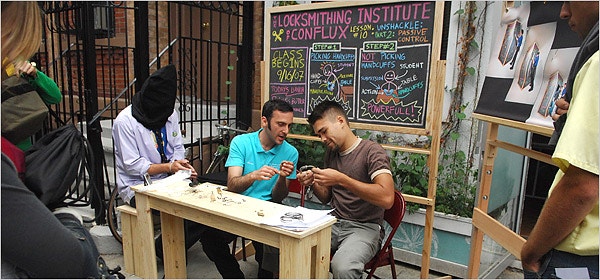
Summary of an article in New York Times by Martha Schwendener on Sept. 18, 2007.
Conflux Festival was an annual NYC festival that celebrated the ideas of Guy Debord, the French co-founder of the Situationist movement and coiner of psychogeography, which describes how the physical environment can affect people’s behavior and emotions. Participants in the Conflux Festival took an independent approach while creating “everything from audio graffiti to surveillance technology” that celebrates Debord’s radical approach to liberation from society.
For example, artists would show up to events with a fluid approach to time, like in a multimedia walking tour that was based on “derive”, or “drifting”, the “transient passage through varied ambiances” in Debord’s words. Appropriately, the tour covered half the number of stops than planned, an hour later than planned.
Technology at the 2007 event was in no shortage. Examples included a guerrilla cell tower, or “audio graffiti” by Michael Dory, that consisted of MP3 players with speakers hidden in disposal objects around the neighborhood.
Debord’s concept of “detournement”, reusing pre-existing artistic elements in a new arrangement, showed up in works like Mouna Andraos’ free cellphone or MP3 charging station created from wine crate, powered by a hand crank and solar panels.
Another popular theme at Conflux was surveillance. Hasan Elahi explored “Sousveillance culture” (a Situationist term meaning watching from below), by wearing his own tracking technology to publicly publish every activity he did. His “from-below” surveillance allowed him to watch himself “better than the government could”, and was inspired by an experience he had with the F.B.I post-9/11.
As for non-technological interventions at Conflux, some examples included improvised street performances, or a “little street library” that ended up being set aflame later in the festival. Another, more anarchist example was a course on how to pick handcuff locks.
The article ends pointing to the overall looseness of the “rules” of Conflux, and that not every-single event at the festival was well aligned with Guy Debord’s work.
Analysis:
This was one of the most comprehensive overviews of Conflux that I could find, as it seems it no longer happens anymore. This article’s analysis of Conflux in Situationist terms was helpful for me to understand the many ways Situationism could manifest in art. I’d like to look more into Situationism and see what type of pushback there is against the movement. Can Situationism address gentrification appropriately? So far I’m not exactly sure.



